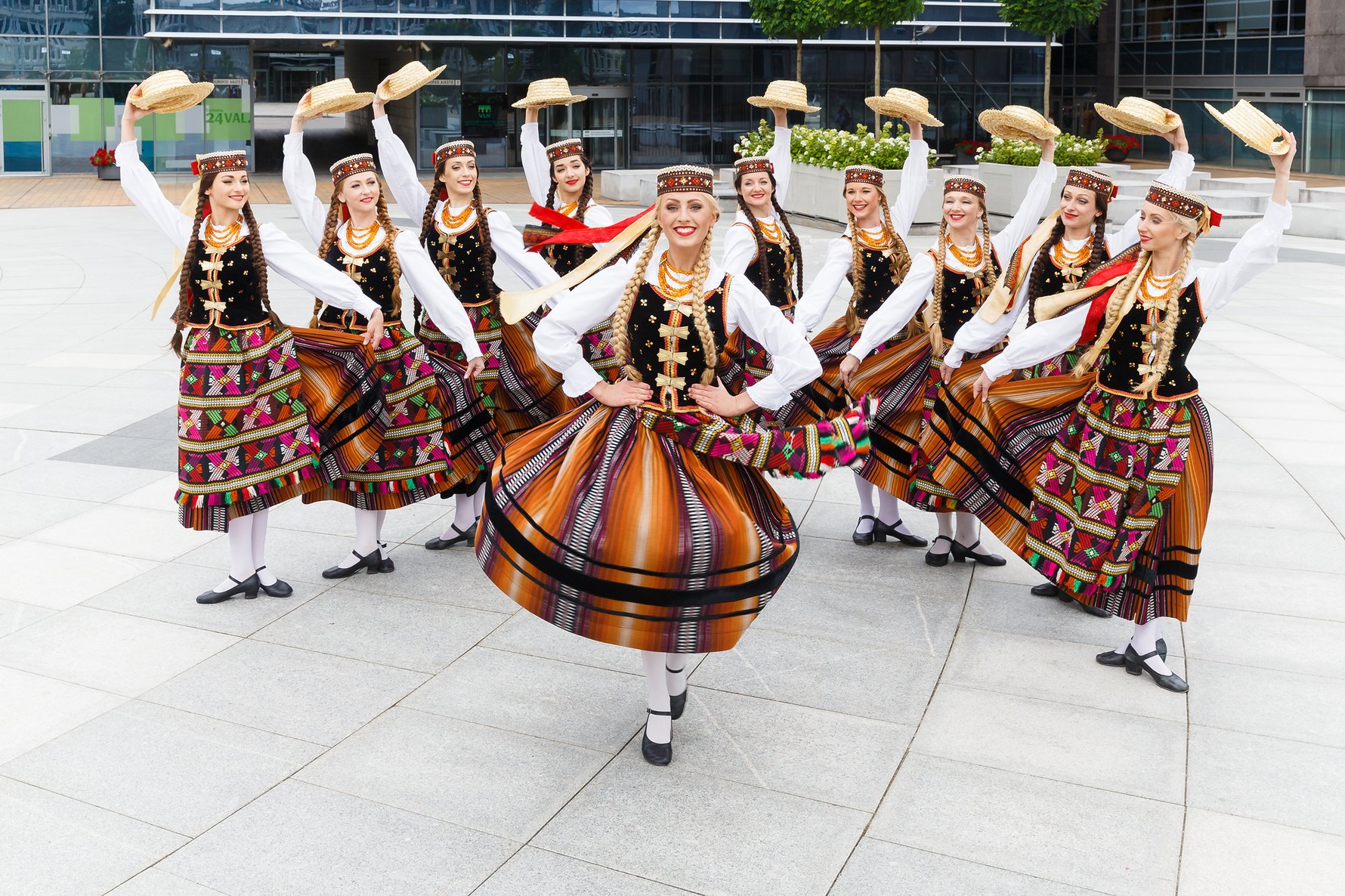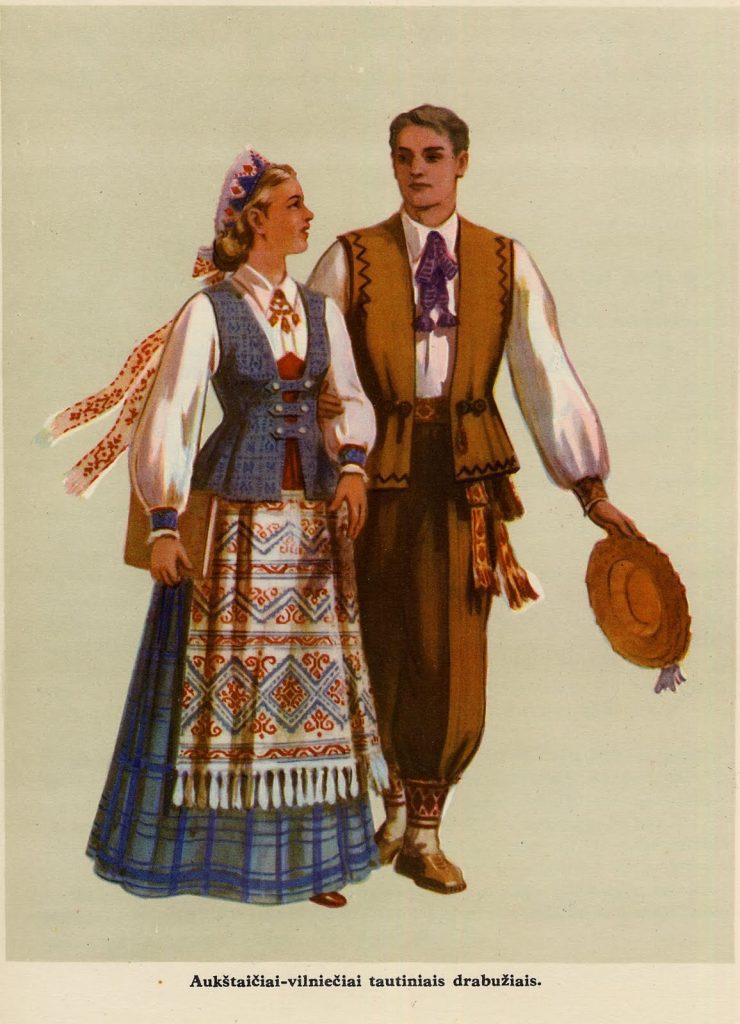Lithuania traditional clothes, known as “tautiniai drabužiai,” are vibrant, culturally rich, and worn during festivals. They feature intricate embroidery, regional styles, and historical influences, with accessories showcasing Lithuania’s artistic craftsmanship.
Lithuania, a small Baltic country, has a rich and unique culture. One of the most important aspects of Lithuanian culture is its traditional clothing. Lithuania traditional clothes is not only beautiful, but it also has a deep meaning and symbolism.
Lithuania traditional clothes comprises two main parts: the shirt and the skirt. The shirt is always white and made of linen. It has long sleeves and a high collar.
The skirt is usually made of wool or linen and is decorated with embroidery or other embellishments. One of the most important things to know about Lithuania traditional clothes is that I do not wear it for work or for everyday activities. Someone only worn traditional clothes on special occasions, such as weddings, funerals, church festivals, and other important events.
This is because I saw traditional clothes as being very sacred and all Lithuanians respect them.
Lithuania is a small country in Europe with a rich culture and history. Lithuania traditional clothes is colorful and unique and often includes intricate embroidery. The national dress of Lithuania is called the rubes.
It is a long, sleeveless tunic that reaches down to the knees or ankles. The rubs is usually made of linen or wool and is decorated with beautiful embroidery. Women also wear a white blouse underneath the rubes.
Both men and women wear folk costumes when taking part in traditional dances or other cultural events. The most commonly worn costume is the kauris, which comprises a shirt, pants, waistcoat, and jacket. This outfit is often brightly colored and adorned with embroidery or other embellishments.
Lithuania traditional clothes is both beautiful and practical. The fabrics are sturdy and can withstand the harsh winters of Lithuania, but are also light enough to be comfortable in summer months. If you ever have the chance to visit Lithuania, be sure to check out the traditional clothing!

Credit: www.inyourpocket.com
What is the Lithuania Traditional Clothes?
Lithuania has a long history of textile production and traditional clothing. The most common fabrics used in Lithuania traditional clothes are linen and wool. They used linen for shirts, skirts, aprons, towels and tablecloths.
I used wool for outerwear such as cloaks, coats and trousers. Traditional Lithuanian clothing is often bright coloured and decorated with embroidery. The most iconic item of Lithuania traditional clothes is the Scots, a linen shirt worn by both men and women.
I made Scots from one piece of fabric with no side seams. Someone usually decorate them with geometric patterns or folk motifs using either embroidery or cross-stitch. Another popular item of Lithuania traditional clothes is the rain’s, a woolen cloak worn by both men and women.
Russians are usually dyed black or dark blue and trimmed with fur. Lithuanian traditional dress is not complete without headwear. Women often wore scarves or kerchiefs to cover their hair, while men wore hats known as parks.
What are Traditional Outfits Called?
There is no one answer to this question, as traditional outfits vary depending on culture and location. However, traditional outfits are often called “national dress” or “folk costume.” They typically comprise clothing that is specific to a certain country or region, and which often has symbolic meaning.
Traditional outfits are usually passed down from generation to generation and are worn on special occasions or for cultural events.
What are Some Lithuanian Traditions?
Lithuania is a country with a rich history and many unique traditions. Some of the most popular Lithuanian traditions include:
1. Easter Egg Hunting – Easter is one of the most important holidays in Lithuania and egg hunting is a popular activity for children.
Families will often hide eggs around their homes and gardens for the kids to find.
2. Midsummer’s Eve – Midsummer’s Eve, or St John’s Day, is celebrated on June 24th each year. It is traditional to decorate your home with greenery and flowers on this day, as well as staying up late to enjoy the longest day of the year.
Bonfires are also commonly lit on Midsummer’s Eve.
3. Christmas Eve – Christmas Eve is celebrated in a similar way to other countries, with a large family dinner and exchanging of gifts. However, one unique tradition is that an empty chair is always left at the table in case any guests should drop by unannounced!
4. Kite Flying – flying kites is a popular pastime in Lithuania, especially during the springtime months when there are plenty of windy days perfect for getting them airborne! Kite festivals are also held annually in some parts of the country.
Which is the Most Famous Traditional Dress?
There are many traditional dresses around the world that are famous for their unique designs and colors. However, there is no definitive answer which one is the most famous. Some of the most popular traditional dresses come from countries like China, India, Japan, and Mexico.
Each of these countries has a rich history and culture that is reflected in their traditional clothing. China’s top dress is one of the most iconic and well-known traditional dresses in the world. The hope is a form-fitting dress that was originally worn by women in the Qing Dynasty (1644-1912).
It has since evolved into a modern fashion item that is popular both inside and outside of China. India’s sari is another widely recognized traditional dress. Saris are typically made of brightly colored fabric and can be draped in various ways.
Someone often adorn them with intricate patterns and embroidery, making them exquisite to look at. Japan’s kimono is another iconic traditional dress. I usually make kimonos from silk and are available in a wide variety of colors and designs.
I often wore them on special occasions such as weddings or tea ceremonies. Mexico’s traditional dress varies depending on the region, but some of the most common items include the sarape (a type of blanket),the rebozo (a shawl),and the huipil (a blouse). These garments are often brightly colored and decorated with intricate patterns.
Lithuanian Clothing Brands
Lithuanian clothing brands are some of the most stylish and unique in the world. With a focus on quality and craftsmanship, these brands have become known for their attention to detail and trend-setting designs. Here are just a few of our favorite Lithuanian clothing brands:
1. LENTEK Founded in 2009, Lestek is a contemporary women’s wear brand that offers The Avant-Garde take on classic silhouettes. Their pieces are both refined and edgy, with an emphasis on clean lines and muted colors.
2. KASPARAS URBONAS Kasparus Urbonas is a men’s luxury fashion brand that specializes in handcrafted suits and shirts. Their impeccable tailoring has earned them a loyal following among discerning gentlemen worldwide.
3. BALTIC APPAREL COMPANY (BAC) BAC was founded in 2014 to create high-quality streetwear inspired by Lithuanian culture and history. Their bold prints and graphic tees are must-haves for any fashion-savvy individual.
Lithuania Traditional Clothes, for Sale
If you’re looking for a Lithuania traditional clothes, there are plenty of places to buy one. You can find many online retailers that sell Lithuanian clothing, as well as brick-and-mortar stores. Prices will vary depending on the quality of the materials and workmanship, but you can expect to pay anywhere from $50 to $500 for a dress.
The most important thing to keep in mind when shopping for a Lithuanian dress is to make sure that I made it from high-quality materials. It made the best dresses from linen or wool, which are both durable and comfortable. You should also look for a dress that is well-constructed, with sturdy seams and hems.
If you want your dress to last for many years, it’s worth investing in a higher-quality garment. When choosing a style of Lithuanian dress, there are many options to choose from. Traditional styles include long dresses with full skirts and billowing sleeves, as well as shorter tunic-style dresses.
You can also find modern takes on the Lithuanian dress, such as fitted silhouettes and knee-length skirts. No matter what style you prefer, you’ll be able to find a beautiful Lithuanian dress to suit your taste.
Traditional Lithuanian Men’s Clothing
I have always known Lithuanian men for their unique and traditional style of clothing. The most common item of clothing worn by Lithuanian men is the shirt. It usually made shirts out of linen and were white.
Someone would often decorate them with embroidery or other colorful designs. Another piece of traditional Lithuanian men’s clothing is the best. It usually made vests out of wool and were often brightly colored.
I wore them over the shirt and kept warm in the colder months. Trousers were also a common item of clothing worn by Lithuanian men. It usually made them out of linen or cotton and came in a variety of colors.
It would often tuck pants into boots when it was cold outside. Last but not least, Lithuanian men would also wear hats to protect them from the sun and rain. Common hat styles included the fedora, beanie, and cap.
Conclusion
Lithuania is a country with a rich history and culture. The traditional clothing of the Lithuanian people is both beautiful and unique. The most commonly worn item of clothing is the dirndl, which is a type of skirt.
Dirndls are usually made from linen or wool and are decorated with embroidery or other embellishments. Other items of Lithuania traditional clothes include the kauri (a type of shirt), the signal (a long dress), and the vesta (a short jacket). Lithuania traditional clothes is not only beautiful, but it also has a lot of meaning and symbolism behind it.
For example, we often see the dirndl skirt as a symbol of femininity, while the kauri shirt represents strength and masculinity. The colors and patterns used in traditional Lithuanian clothing also have special significance. For instance, white is often associated with purity, while red signifies power and courage.

